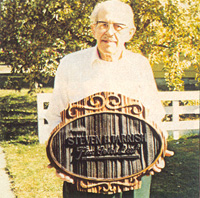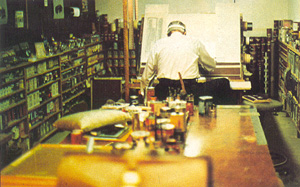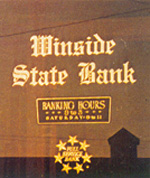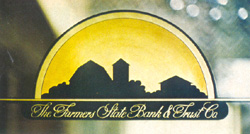|
Steven H. Parrish; Goldleaf Signs
Copyright 1982. Signs of the Times magazine
From Signs of the Times magazine; April, 1982 issue,
pp 58
by Lynn B. Blaine
 Steven Parrish holds a sign
sandblasted for him as a surprise by Mike Jackson,
who first told ST of Parrish's work. The sign
awaits the goldleaf master's touch.
Steven Parrish holds a sign
sandblasted for him as a surprise by Mike Jackson,
who first told ST of Parrish's work. The sign
awaits the goldleaf master's touch. |
|
"Do you still work full-time?" I asked Steven Parrish,
a 72-yr. old goldleaf signman whose work covers Wyoming,
Nebraska, Oklahoma, Texas and Iowa. (Oh, how I fall
into those questions you wish you had never asked.)
"Oh, sure, I even work full-overtime. When I hear somebody
say something about looking forward to retirement, I
think, 'Oh, Lord, here goes another one down the drain,
ready for the undertaker.' Maybe I'm crazy, or it might
be that I'm just too foolish to know any better, but
I just go right on working, rowing my boat and being
independent.
|
"I remember back when I was about 14 or 15, I met an old signpainter
who had snapped signs all over the world. He was snapping some
signs in my hometown, Sandusky, MI, and told me he was 78 years
old. The next time I saw him I was probably somewhere in my
30's, and he said he was 'only 68' - and you couldn't tell the
difference one way or the other, because he hadn't changed.
A fellow like that gives you something to look up to."
Parrish started painting signs before most could learn how
to read - at age five - although those first seven years in
the trade he admittedly held amateur status. Translated, he
didn't get paid. It was not until he was 12 (almost a teenager!)
before he actually charged for his work. Then, in 1921 or
1922, his school needed a scoreboard, so for the "princely
sum" of $8, Parrish set to work on a 4 x 8-ft. sign. His reputation
established, two years later he was asked to goldleaf the
door of the county treasurer's office, which had been destroyed
during a robbery. He had never done goldleaf work before,
and for this particular job he had to match a difficult Brewster
green, put in some red and gold stripping, and do some gold
lettering with a shade. Nevertheless, he did the job, and
then another, because by the time he graduated from high school,
he was earning what he reports was twice as much money as
the average married man. Of course, it's doubtful if the "average
working man" had what Parrish could claim in those days, all
those years of experience under his belt in a skilled profession.
| Parrish doesn't
remember how many hours he was working at signpainting
during high school. He did a lot of work for the school
itself. In his words, "they stopped the clock" for him,
giving him as much time as he needed to complete a project.
The teacher gave him the last 45 minutes of every day
to do as he pleased - sketching, getting ideas, designing. |

Proof of an organized man: an
organized shop.
|
|
Parish grew up in Michigan, where strikes in the auto industry
took their toll on the business environment and the moisture
in the air took its toll on goldleaf. He recalls complaining
to his wife back in 1949 that if there weren't any better climate
in the U.S. than Michigan's, he would get a two-dollar pistol
and shoot himself. Thirty days later they found themselves alive
and well in Texas, where, he reports, the weather was better
than the market. So he set up shop in Nebraska a year later,
finding it easier to create his own market there. He has been
in Nebraska ever since, the colder but drier air providing a
better atmosphere for the leaf he applies so well.
Since most goldleaf is wet-gilded (put on with a water and
gelatin size), the gold will loosen if water gets to it. Moisture
from the air condensing on windows can work its way throught
the porosity of the glass, giving goldleaf a much shorter
life span. (In those e years, putting varnish on first was
not a common practice.) In Nebraska, and its neighboring states,
Parrish finds that it is not unusual for his work to last
for 30 years.

Examples of back-to-back, vertically
screenprinted patterns, with 23K hand-embossed gold.
|
|
When Parrish moved to Nebraska, he found
people who appreciated goldleaf. He isn't sure why, but
he noticed that there were certain landmarks that would
help him establish his business in much the same way that
hobos' marks serve as a hobo newspaper, indicating likely
places for a handout. Parrish found that "an old boy"
by the name of H.A. Liberty, who did very fine work, had
been a trailblazer: In towns where Parrish found examples
of Liberty's work, he also found it easier to build his
own market. |
| How did he do it? He recalls
that when he was 13, a client advised him, "When you go
out on the road to make money, make sure to do business
with the people who have it." When Parrish started out,
he found that bankers were the ones who had it, so he
went after bank business and found that the approach worked
very well. He does almost all of his work for banks these
days. |

The outter rim over the farm scene
is pale gold. |
|
He made a miniature sample case with plate glass samples
carried in felt, showing different styles and kinds of goldleaf.
Taking pictures of his work with him as well, he just walked
into banks, and he came back out, on the average, with a contract
from one out of three banks he called on. He has been doing
almost nothing except goldleaf for the last 30 years.
"If you're going to be spreading your efforts in different
directions all the time, you don't get as much accomplished.
You're much better off to specialize on one thing and let
somebody else do the other work," is his advice.

The work of H. A. Liberty, who
opened the way for Parrish 60 years ago. |
|
For Parrish, doing it right
means using japan gold size, made out if tree gun from
China melted down with turpentine. This he puts on with
a fine squirrel-hair brush. For his pictorial work, he
finds the best approach is to use his own process of vertical
screen printing for the pattern. He blows up his design
to a size somewhat larger than he intends to paint it,
smoothes out the edges and makes the details sharp, photographically
reduces it back to proper size, and screens the design
on the glass.
|
Doing it right also means taking the time to do a back-to-back
sign carefully, putting on a panel and applying two coats of
23K gold so that no light comes through and the sign can be
read from both sides. "If all you worry about is hurrying up
to get the sign collectible, you had better forget it," he admonishes.
Competition? Parrish doesn't claim to have much - or any
at all. He reports, with a chuckle, that all the competition
has died off. Sure, there are plenty of "upstarts," but only
one or two who will take the time to "do it right." And he
should know: He ends up repairing the work that wasn't done
properly to begin with. When asked how he gets his business,
he replies, again with a chuckle, that if people haven't heard
of him in his environs, then they just haven't been there
very long, that's all.
| Parrish claims that he doesn't
know how he would have stayed in business if his sixth
sense hadn't told him to stock up on good japan size when
the opportunity struck. He prefers a certain varnish he
had purchased made by Commonwealth, which was sold out
in the 1960's. After it was sold, he found that the two
cases of varnish he had purchased were not the same material.
"It wasn't fuel oil, and it wasn't crude oil, and it wasn't
varnish or anything that resembled it," he claims. |

23K matte gold, hand embossed
on verticallly screenprinted patterns. "Aurora Jewelry"
has back shade; mdiamond shape behind black. "Aurora"
is 16K pale gold. |
|
"It had a sediment at the bottom and smelled horrible, and when
I tried to brush it, it wouldn't dry, so I threw the two cases
out in the garbage. Later he heard through the grapevine that
Dick Blick still had some of the old product they didn't know
they had, so Parrish packed his bags immediately and got in
the car top drive the 700 miles to scrounge up two more cases
"before anybody else could get to it." He has been using the
same two cases ever since, having found that he could thin it
down with more pure gum turpentine when the varnish starts to
thicken as the can is emptied.
He tells a similar story about some red sable brushes he
acquired on the advice of a signpainter who happened to mention
that he had bought some "darned good brushes" form a particular
supplier. Again, Parrish jumped in his car and latched onto
a bunch of red sable brushes. By 1950 the price of those brushes
had gone up to $80 - and he still has some of them.
How long did it take Parrish to master his craft? "Well,"
he says, "I'm still learning. You never stop learning in my
business: It's a matter of speed rather than years. In one
way you're on a par with the fellow who just started yesterday,
except for the fact that you have a little more knowledge
to begin with. It is still a tough job to do. It probably
took me about 20 years to get to the point where I was on
top of it, doing as much as the market would allow."
|
|
Parrish does all
of his own designing. He will incorporate logos, but otherwise
does not deviate from his own designs. His point is that
he tells his what he will do and what the quality will
be. And then it is up to him to deliver. And he is pleased
to tell about his sign that have lasted for 20 or 30 years
without even being revarnished. |
He is entirely self-taught, although he has studied whatever
books he came across (That were any good) down to the last detail.
He has always liked lettering more that other aspects of signpainting,
and his feeling is that, with 6,000 to 7,000 alphabets available
to anybody who wants to dig them out, there will be one that
will be appropriate for each particular job. "The further you
go," he advises, "the more you appreciate the value of these
things, and that's why you have to integrate the idea and make
it mean something. In other words, to just put up a row of letters
doesn't mean anything; that doesn't make a sign. A sign has
characteristics to it that really make it sell, make it carry
out the theme that is intended. It's a means of conveying an
idea so that the next time a fellow who sees it will get the
same idea out of it." And as far as talent goes, he adds, "It's
how much artistry you have in your soul: If you can see it in
your mind's eye, you can carry it out."
Experience teaches things like how to consider the exposure
a sign gets, since the amount of light and the height of the
sign will determine what sort of gold top use. Parrish lets
the deeper gold predominate in the heavy end of the lettering,
doing the ornamentation in pale or lemon gold.
| One technique he doesn't have much call
for now, but which he likes, is using a matte center with
a varnished outline, for which he lays on 23K gold with
a wet size, lets it dry, burnished it, and banks up the
outline 1/16 or ¼ inch. Then on the inside of the letter
he applies japan gold size, gilds and embosses the varnish.
When it is dry, he goes over it with a wet gild and lays
the gold into the size, giving the appearance of having
been chiseled out. "It used to be," he says, "that if
you were going to do an embossing job, you had to use
white damar varnish and in a matter of seconds take an
embossing stick and kind of gouge out the stuff." |
|
|
|
He doesn't have much call for it now because
of the price, although he used to do it frequently. He
recently recommended to one bank that, instead of trying
to change such a sign to incorporate a new name change,
they should take out the |
| plate glass, cut it down, and mount the piece on a pedestal
in the lobby. (Replacing such a sign today costs around
$3,000.) |
What are the differences between "then" and "now" for a
goldleaf specialist? The market conditions, for one thing.
It usually takes a burgeoning economy to support goldleaf,
and goldleaf also takes a bit of selling, Parrish reports,
but he finds it easier to sell goldleaf today. Although inflation
has driven the price of gold up considerably (the pack of
gold that now costs Parrish from $300 top $800 used to cost
him $6.75 - yes, that's right: $6.75 - when he started, back
in the days of the gold standard) price doesn't seem to be
the stumbling block that it used to be and hasn't been since
the price of gasoline started shooting up. He finds that his
customers will spend "almost anything," because they feel
that their money isn't worth the 3 A's: "anything," "anymore,"
"anyway." Customers are willing to go first class if they
see work that is well designed, well executed and gives the
image that they want. His business is as much human nature
as anything else.
Inflation and the rising price of gold have made some changes
in the amount of gold Parrish keeps in stock. At today's going
rate, he doesn't keep much extra around. Whereas he used to
keep about 10 too 12 packs, now his safety deposit box has
five or six in it. He stocks every color of gold, always carrying
a pack of white (12K, half silver and half gold), pale gold
(16K), lemon gold (181/2K), and surface, glass and patent
gold (all 23K).
| He uses the surface gold when
he wants gold to be completely opaque in two applications
for a double-sided sign. Glass gold is the thinnest and
is used for the finest finish. Patent is for guiding in
the wind; it is attached to paper similar to hamburger
wrap and is pressed directly onto the size.
|
|
Parrish finds little calls for silver leaf and basically hasn't
done any of it since the 1950's. The one admonition he has for
silver leafing is not to use varnish, which will hasten the
tarnishing process. He prefers to use white gold (12K) for its
greater warmth.
|
|
The signs Parrish produces give
the same impression that his shop gives: carefully organized,
carefully laid out, everything tidy and right were he
needs it. Although he politely claims to have disarrayed
desktops and need of endless shelves to put his clutter
on, the neatly stacked cans arranged around his workspace,
the rules hanging in graduated lengths by his table, the
recordings that arrive from him, neatly taped shut with
tabs for removing the tape al bespeak an organization
ands attention to detail that is echoed in the care he
takes in his work.
|
Parrish takes pride in performing his craft well, marketing
it straightforwardly and valuing and evaluating the quality
of his own work so well that his customers will also. As he
says himself, his work's quality and his knowledge of his craft
sell his signs. He is in the enjoyable position if knowing that
quality, not price, is his sales tool. He not infrequently has
had his signs encased in weather-proof glass cases, factory
sealed with mitered edges, where his goldleaf will last for
many decades and is likely to be viewed as what it is - a piece
of art, carefully executed down to fine details, which also
happens to be a sign.
Parrish on Pricing
With all the tax money being milked from you-know-who
for the purposes of education, ignorance seems to be holding
its own and making better headway than ever. I often wonder
if in our trade many good artisans, being caught between
a rapidly disappearing apprentice system and as increasingly
expensive educational system, have been compelled to miss
the advantages of both systems and walk a narrow road
to making a living.
My recollections do not call to mind an apologetic
attitudes among signmen of 40 or 50 years ago. They
knew the business, for the most part, and were not ashamed
of it. But this hang-dog whimpering about prices ("you
may get it there, but you can't get it here") seems
to me to be becoming a more vicious evil than the fabled
drunks of yesteryear.
This fawning, slavering, unnecessary explanation of
why they don't charge more for their work has just about
convinced me that they know the price of everything
and the value of nothing. Cost studies concerning goldleaf
work are a field day for the apologists who couldn't
tell you to save their soul why their work is priced
at $.35 or $.45 or $.60 an upright inch. There is room
here for some realistic upgrading of what passes fore
thinking. Who said you should charge such ridiculously
low prices, unless, of course, you don't know what you
are doing? And on that basis you cannot afford to find
out any more than you know now.
I have on many occasions demonstrated to signmen who
said, "I wouldn't dare quote prices like that," that
price has little if anything to do with it. This can
be done easily by asking him to introduce you to the
customer, nothing more. In 15 minutes I will find out
want he wants, and he will find out what it is worth
to do it. I've never lost a customer worth having because
of price. Now, of course, you will tell me, "Well, you
have a special pitch that works>" I do not. I just talk
to a man at his own level, respectfully and in terms
he can understand, and try to answer all his questions
in a simple, straightforward manner.
I had neither the opportunity to apprentice to a sign
shop nor the dubious advantage of an educational (so
I wouldn't have to work for a living, riding the sheepskin
trail to certain success), but I haven't missed the
opportunity to learn all I could about my own business.
When you do this year after year, it will become impossible
to conceal that fact from the customer. He'll be led
to the conclusion that you know what you are doing,
and this in itself, by way of contrast and novelty on
today's market, will make the price issue superficial
and worthless. Value is determined not by what you pay,
but by what you get for what you pay.
It seems to me that too many of us have a tendency
to underrate the value of what we have to offer, with
the exception of a small minority of egotistical novices
who squash an inferiority complex with a bravado which
embraces neither knowledge nor wisdom. As Everett Kay
White always said of this kind, "He talks a good sign.
I wonder how he paints one."
I have observed for many years two reliable gauges
concerning prices. The first is this: If nobody screams
about the price, it is probably too low. If everybody
screams about it, it may be a little high, but if you
know your business, don't flinch an inch. I heard a
seasoned old signman say once, "if you know what you
are doing, the price isn't too high; but if you don't
know what you are doing, you had better take it a little
easy."
My father taught me when I was small to memorize this:
Knowledge is the stuff that wins.
The man without it soon begins
To get his trade in kinks.
No matter where a fellow goes
He's valued for the things he knows
And not the things he thinks.
Respectfully,
(signed) Steven A. Parrish
|
|